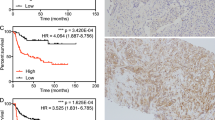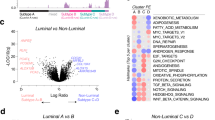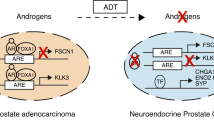Abstract
Progression to androgen independent (AI) is the main cause of death in prostate cancer, and the mechanism is still unclear. By reviewing the expression profiles of 26 prostate cancer samples in a holistic view, we found a group of genes differentially expressed in AI compared with androgen-dependent groups (P-value<0.01, t-test). Focusing on apoptosis, proliferation, hormone and angiogenesis, we found a group of genes such as thioredoxin domain containing 5 , tumor necrosis factor receptor superfamily, member 10a , ribosomal protein S19 and Janus kinase 2 upregulated in AI prostate cancer, could play important roles in the transition from AD to AI and could be biomarkers of prognosis.
This is a preview of subscription content, access via your institution
Access options
Subscribe to this journal
Receive 4 print issues and online access
$259.00 per year
only $64.75 per issue
Buy this article
- Purchase on Springer Link
- Instant access to full article PDF
Prices may be subject to local taxes which are calculated during checkout



Similar content being viewed by others
Accession codes
Accessions
GenBank/EMBL/DDBJ
References
Eisenberger MA, Carducci MA . Chemotherapy for hormone-resistant prostate cancer. In:Walsh PC, Retik AB, Vaughan DE, Wein AJ (eds). Campbells Urology, 8th edn. Elsevier: Philadelphia, 1998, pp 3209–3226.
Logothetis CJ, Hoosein NM, Hsieh JT . The clinical and biological study of androgen independent prostate cancer (AI PCa). Semin Oncol 1994; 21: 620–629.
Taplin ME, Bubley GJ, Shuster TD, Frantz ME, Spooner AE, Ogata GK et al. Mutation of the androgen-receptor gene in metastatic androgen-independent prostate cancer. N Engl J Med 1995; 332: 1393–1398.
Naslund MJ, Coffey DS . The differential effects of neonatal androgen, estrogen and progesterone on adult rat prostate growth. J Urol 1986; 136: 1136–1140.
Bektic J, Wrulich OA, Dobler G, Kofler K, Ueberall F, Culig Z et al. Identification of genes involved in estrogenic action in the human prostate using microarray analysis. Genomics 2004; 83: 34–44.
Gasparini G, Weidner N, Bevilacqua P, Maluta S, Dalla Palma P, Caffo O et al. Tumor microvessel density, p53 expression, tumor size, and peritumoral lymphatic vessel invasion are relevant prognostic markers in node-negative breast carcinoma. J Clin Oncol 1994; 12: 454–466.
Jackson MW, Bentel JM, Tilley WD . Vascular endothelial growth factor (VEGF) expression in prostate cancer and benign prostatic hyperplasia. J Urol 1997; 157: 2323–2328.
Borre M, Nerstrom B, Overgaard J . Association between immunohistochemical expression of vascular endothelial growth factor (VEGF), VEGF-expressing neuroendocrine-differentiated tumor cells, and outcome in prostate cancer patients subjected to watchful waiting. Clin Cancer Res 2000; 6: 1882–1890.
Holloway AJ, van Laar RK, Tothill RW, Bowtell DD . Options available-from start to finish-for obtaining data from DNA microarrays II. Nat Genet 2002; 32 (Suppl): 481–489.
Li Y, Li Y, Tang R, Xu H, Qiu M, Chen Q et al. Discovery and analysis of hepatocellular carcinoma genes using cDNA microarrays. J Cancer Res Clin Oncol 2002; 128: 369–379 [E-pub 20 June 2002].
Sambrook J, Russell DW . Using PCR to amplify DNA in vitro. In: Argentine J (ed) Molecular Cloning: A Laboratory Manual, 3rd edn. Cold Spring Harbor Laboratory Press: NY, 2001.
Berger JA, Hautaniemi S, Jarvinen AK, Edgren H, Mitra SK, Astola J . Optimized LOWESS normalization parameter selection for DNA microarray data. BMC Bioinformatics 2004; 5: 194.
Gunawardena RW, Siddiqui H, Solomon DA, Mayhew CN, Held J, Angus SP et al. Hierarchical requirement of SWI/SNF in retinoblastoma tumor suppressor-mediated repression of Plk1. J Biol Chem 2004; 279: 29278–29285.
Takahashi T, Sano B, Nagata T, Kato H, Sugiyama Y, Kunieda K et al. Polo-like kinase 1 (PLK1) is overexpressed in primary colorectal cancers. Cancer Sci 2003; 94: 148–152.
Ree AH, Bratland A, Nome RV, Stokke T, Fodstad O . Repression of mRNA for the PLK cell cycle gene after DNA damage requires BRCA1. Oncogene 2003; 22: 8952–8955.
Liu X, Erikson RL . Polo-like kinase (Plk)1 depletion induces apoptosis in cancer cells. Proc Natl Acad Sci USA 2003; 100: 5789–5794.
Weichert W, Schmidt M, Gekeler V, Denkert C, Stephan C, Jung K et al. Polo-like kinase 1 is overexpressed in prostate cancer and linked to higher tumor grades. Prostate 2004; 60: 240–245.
Schafer B, Marg B, Gschwind A, Ullrich A . Distinct ADAM metalloproteinases regulate G protein-coupled receptor-induced cell proliferation and survival. J Biol Chem 2004; 279: 47929–47938 [E-pub 26 August 2006].
Borrell-Pages M, Rojo F, Albanell J, Baselga J, Arribas J . TACE is required for the activation of the EGFR by TGF-alpha in tumors. EMBO J 2003; 22: 1114–1124.
Ding X, Yang LY, Huang GW, Wang W, Lu WQ . ADAM17 mRNA expression and pathological features of hepatocellular carcinoma. World J Gastroenterol 2004; 10: 2735–2739.
Karan D, Lin FC, Bryan M, Ringel J, Moniaux N, Lin MF et al. Expression of ADAMs (a disintegrin and metalloproteases) and TIMP-3 (tissue inhibitor of metalloproteinase-3) in human prostatic adenocarcinomas. Int J Oncol 2003; 23: 1365–1371.
Kudo Y, Kitajima S, Ogawa I, Kitagawa M, Miyauchi M, Takata T . Small interfering RNA targeting of S phase kinase-interacting protein 2 inhibits cell growth of oral cancer cells by inhibiting p27 degradation. Mol Cancer Ther 2005; 4: 471–476.
Jiang F, Caraway NP, Li R, Katz RL . RNA silencing of S-phase kinase-interacting protein 2 inhibits proliferation and centrosome amplification in lung cancer cells. Oncogene 2005; 24: 3409–3418.
Li JQ, Wu F, Masaki T, Kubo A, Fujita J, Dixon DA et al. Correlation of Skp2 with carcinogenesis, invasion, metastasis, and prognosis in colorectal tumors. Int J Oncol 2004; 25: 87–95.
Shigemasa K, Gu L, O'Brien TJ, Ohama K . Skp2 overexpression is a prognostic factor in patients with ovarian adenocarcinoma. Clin Cancer Res 2003; 9: 1756–1763.
Lu L, Schulz H, Wolf DA . The F-box protein SKP2 mediates androgen control of p27 stability in LNCaP human prostate cancer cells. BMC Cell Biol 2002; 3: 22 [E-pub 20 August 2002].
Gillette JM, Chan DC, Nielsen-Preiss SM . Annexin 2 expression is reduced in human osteosarcoma metastases. J Cell Biochem 2004; 92: 820–832.
Liu JW, Shen JJ, Tanzillo-Swarts A, Bhatia B, Maldonado CM, Person MD et al. Annexin II expression is reduced or lost in prostate cancer cells and its re-expression inhibits prostate cancer cell migration. Oncogene 2003; 22: 1475–1485.
Wang HT, Kong JP, Ding F, Wang XQ, Wang MR, Liu LX et al. Analysis of gene expression profile induced by EMP-1 in esophageal cancer cells using cDNA Microarray. World J Gastroenterol 2003; 9: 392–398.
Sullivan DC, Huminiecki L, Moore JW, Boyle JJ, Poulsom R, Creamer D et al. EndoPDI, a novel protein-disulfide isomerase-like protein that is preferentially expressed in endothelial cells acts as a stress survival factor. J Biol Chem 2003; 278: 47079–47088 [E-pub 8 September 2003].
Koyama S, Koike N, Adachi S . Expression of TNF-related apoptosis-inducing ligand (TRAIL) and its receptors in gastric carcinoma and tumor-infiltrating lymphocytes: a possible mechanism of immune evasion of the tumor. J Cancer Res Clin Oncol 2002; 128: 73–79 [E-pub 12 December 2001].
Kim R, Tanabe K, Emi M, Uchida Y, Toge T . Death receptor-dependent and -independent pathways in anticancer drug-induced apoptosis of breast cancer cells. Oncol Rep 2003; 10: 1925–1930.
Li B, Sun M, He B, Yu J, Zhang YD, Zhang YL . Identification of differentially expressed genes in human uterine leiomyomas using differential display. Cell Res 2002; 12: 39–45.
Zhang X, Grand RJ, McCabe CJ, Franklyn JA, Gallimore PH, Turnell AS . Transcriptional regulation of the human glycoprotein hormone common alpha subunit gene by cAMP-response-element-binding protein (CREB)-binding protein (CBP)/p300 and p53. Biochem J 2002; 368 (Part 1): 191–201.
Graichen R, Liu D, Sun Y, Lee KO, Lobie PE . Autocrine human growth hormone inhibits placental transforming growth factor-beta gene transcription to prevent apoptosis and allow cell cycle progression of human mammary carcinoma cells. J Biol Chem 2002; 277: 26662–26672 [E-pub 6 May 2002].
Berns EM, Dirkzwager-Kiel MJ, Kuenen-Boumeester V, Timmermans M, Verhoog LC, van den Ouweland AM et al. Androgen pathway dysregulation in BRCA1-mutated breast tumors. Breast Cancer Res Treat 2003; 79: 121–127.
Hayami R, Sato K, Wu W, Nishikawa T, Hiroi J, Ohtani-Kaneko R et al. Down-regulation of BRCA1-BARD1 ubiquitin ligase by CDK2. Cancer Res 2005; 65: 6–10.
Gao B, Shen X, Kunos G, Meng Q, Goldberg ID, Rosen EM et al. Constitutive activation of JAK-STAT3 signaling by BRCA1 in human prostate cancer cells. FEBS Lett 2001; 488: 179–184.
Clark BJ, Li J . Janus kinase 2 signaling in the angiotensin II-dependent activation of StAR expression. Endocr Res 2004; 30: 685–693.
Leung KC, Doyle N, Ballesteros M, Sjogren K, Watts CK, Low TH et al. Estrogen inhibits GH signaling by suppressing GH-induced JAK2 phosphorylation, an effect mediated by SOCS-2. Proc Natl Acad Sci USA 2003; 100: 1016–1021 [E-pub 27 January 2003].
Leav I, Merk FB, Kwan PW, Ho SM . Androgen-supported estrogen-enhanced epithelial proliferation in the prostates of intact Noble rats. Prostate 1989; 15: 23–40.
Aguilar R, Bellido C, Benitez de Lupo EA . Differences in prepuberal neonatally estrogenized or androgenized male rats. Andrologia 1987; 19: 183–187.
Tynan S, Pacia E, Haynes-Johnson D, Lawrence D, D'Andrea MR, Guo JZ et al. The putative tumor suppressor deleted in malignant brain tumors 1 is an estrogen-regulated gene in rodent and primate endometrial epithelium. Endocrinology 2005; 146: 1066–1073.
Braidotti P, Nuciforo PG, Mollenhauer J, Poustka A, Pellegrini C, Moro A et al. DMBT1 expression is down-regulated in breast cancer. BMC Cancer 2004; 4: 46.
Mollenhauer J, Herbertz S, Helmke B, Kollender G, Krebs I, Madsen J et al. Deleted in 1 is a versatile mucin-like molecule likely to play a differential role in digestive tract cancer. Cancer Res 2001; 61: 8880–8886.
Ma JF, Takito J, Vijayakumar S, Peehl DM, Olsson CA, Al-Awqati Q . Prostatic expression of hensin, a protein implicated in epithelial terminal differentiation. Prostate 2001; 49: 9–18.
Jung DJ, Sung HS, Goo YW, Lee HM, Park OK, Jung SY et al. Novel transcription coactivator complex containing activating signal cointegrator 1. Mol Cell Biol 2002; 22: 5203–5211.
Palmer DH, Hussain SA, Ganesan R, Cooke PW, Wallace DM, Young LS et al. CD40 expression in prostate cancer: a potential diagnostic and therapeutic molecule. Oncol Rep 2004; 12: 679–682.
Yamaguchi H, Tanaka F, Sadanaga N, Ohta M, Inoue H, Mori M . Stimulation of CD40 inhibits Fas- or chemotherapy-mediated apoptosis and increases cell motility in human gastric carcinoma cells. Int J Oncol 2003; 23: 1697–1702.
Deregibus MC, Buttiglieri S, Russo S, Bussolati B, Camussi G . CD40-dependent activation of phosphatidylinositol 3-kinase/Akt pathway mediates endothelial cell survival and in vitro angiogenesis. J Biol Chem 2003; 278: 18008–18014.
Cao LP, Bolt MJ, Wei M, Sitrin MD, Chun Li Y . Regulation of calbindin-D9k expression by 1,25-dihydroxyvitamin D(3) and parathyroid hormone in mouse primary renal tubular cells. Arch Biochem Biophys 2002; 400: 118–124.
Komatsu K, Murata K, Kameyama M, Ayaki M, Mukai M, Ishiguro S et al. Expression of S100A6 and S100A4 in matched samples of human colorectal mucosa, primary colorectal adenocarcinomas and liver metastases. Oncology 2002; 63: 192–200.
Srinivasan S, Bunch DO, Feng Y, Rodriguiz RM, Li M, Ravenell RL et al. Deficits in reproduction and pro-gonadotropin-releasing hormone processing in male Cpefat mice. Endocrinology 2004; 145: 2023–2034 [E-pub 8 January 2004].
Hougaard DM, Larsson LI . Carboxypeptidase E in rat antropyloric mucosa: distribution in progenitor and mature endocrine cell types. Histochem Cell Biol 2004; 121: 55–61 [E-pub 6 Decemebr 2003].
Slongo ML, Zampieri M, Onisto M . Expression of matrix metalloproteases (MMP-2, MT1-MMP) and their tissue inhibitor (TIMP-2) by rat sertoli cells in culture: implications for spermatogenesis. Biol Chem 2002; 383: 235–239.
Ylitalo K, Nuotio I, Viikari J, Auwerx J, Vidal H, Taskinen MR . C3, hormone-sensitive lipase, and peroxisome proliferator-activated receptor gamma expression in adipose tissue of familial combined hyperlipidemia patients. Metabolism 2002; 51: 664–670.
Bednarek MA, Feighner SD, Hreniuk DL, Palyha OC, Morin NR, Sadowski SJ et al. Short segment of human melanin-concentrating hormone that is sufficient for full activation of human melanin-concentrating hormone receptors 1 and 2. Biochemistry 2001; 40: 9379–9386.
Fernandez A, Udagawa T, Schwesinger C, Beecken W, Achilles-Gerte E, McDonnell T et al. Angiogenic potential of prostate carcinoma cells overexpressing bcl-2. J Natl Cancer Inst 2001; 93: 208–213.
Qi JH, Ebrahem Q, Moore N, Murphy G, Claesson-Welsh L, Bond M et al. A novel function for tissue inhibitor of metalloproteinases-3 (TIMP3): inhibition of angiogenesis by blockage of VEGF binding to VEGF receptor-2. Nat Med 2003; 9: 407–415.
Cross NA, Chandrasekharan S, Jokonya N, Fowles A, Hamdy FC, Buttle DJ et al. The expression and regulation of ADAMTS-1, -4, -5, -9, and -15, and TIMP-3 by TGFbeta1 in prostate cells: relevance to the accumulation of versican. Prostate 2005; 63: 269–275.
Darnton SJ, Hardie LJ, Muc RS, Wild CP, Casson AG . Tissue inhibitor of metalloproteinase-3 (TIMP-3) gene is methylated in the development of esophageal adenocarcinoma: loss of expression correlates with poor prognosis. Int J Cancer 2005; 115: 351–358.
Miyazaki T, Kato H, Nakajima M, Faried A, Takita J, Sohda M et al. An immunohistochemical study of TIMP-3 expression in oesophageal squamous cell carcinoma. Br J Cancer 2004; 91: 1556–1560.
Acknowledgements
This research is supported by a project 30371422 from the National Natural Science Foundation of China.
Author information
Authors and Affiliations
Corresponding author
Rights and permissions
About this article
Cite this article
Wei, Q., Li, M., Fu, X. et al. Global analysis of differentially expressed genes in androgen-independent prostate cancer. Prostate Cancer Prostatic Dis 10, 167–174 (2007). https://doi.org/10.1038/sj.pcan.4500933
Received:
Accepted:
Published:
Issue Date:
DOI: https://doi.org/10.1038/sj.pcan.4500933
Keywords
This article is cited by
-
Systemic lupus erythematosus and prostate cancer risk: a pool of cohort studies and Mendelian randomization analysis
Journal of Cancer Research and Clinical Oncology (2023)
-
Androgens, aging, and prostate health
Reviews in Endocrine and Metabolic Disorders (2022)
-
Powerful p-value combination methods to detect incomplete association
Scientific Reports (2021)
-
The prognostic utility of the transcription factor SRF in docetaxel-resistant prostate cancer: in-vitro discovery and in-vivo validation
BMC Cancer (2017)
-
Early side effects and first results of radioligand therapy with 177Lu-DKFZ-617 PSMA of castrate-resistant metastatic prostate cancer: a two-centre study
EJNMMI Research (2015)



